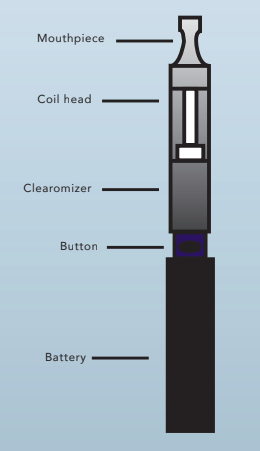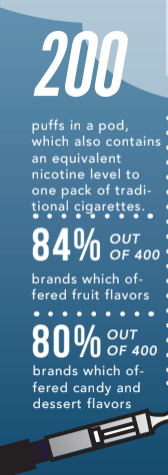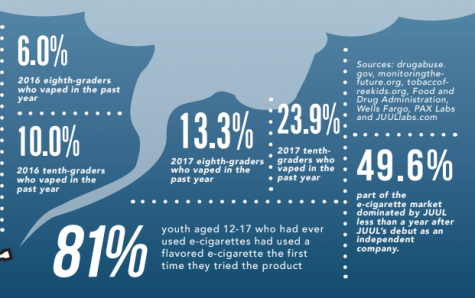The evolution of cigarettes: Vaping trend popularizes among youth
May 7, 2018
In light of the recent surge in the popularity of JUUL devices, the US Food and Drug Administration (FDA) embarked on a nationwide crackdown on teenage e-cigarette use by tightening regulations, issuing warning letters to 40 retailers for selling e-cigarette products to youth and taking down several eBay listings of JUUL products and other vaping devices.
“We understand, by all accounts, many [kids] may be using products that closely resemble a USB flash drive, have high levels of nicotine and emissions that are hard to see. These characteristics may facilitate youth use, by making the products more attractive to children and teens,” the FDA said in a statement. “For this reason, the FDA must – and will – move quickly to reverse these disturbing trends, and, in particular, address the surging youth uptake of JUUL and other products.”
Vaping in general is defined to be the practice of inhaling and exhaling aerosol, or vapor that contains fine particles, from a device such as an e-cigarette. These devices may contain substances such as nicotine or THC, but they do not contain natural tobacco or cannabis.
JUULs are vaping devices manufactured in San Francisco by e-cigarette company PAX labs. At 34.99 dollars online, the devices are significantly more expensive than traditional cigarettes, which typically cost between six and eight dollars. JUULs were initially marketed as a substitute to cylindrical vaporizers, which had long dominated the e-cigarette market and were intended for adults aiming to quit smoking.
“Vaping was a means to an end of smoking, and I found that after a quarter and a half that I didn’t super love it,” a Harker alum who owns a cannabis vape pen said. “I didn’t dislike it either, but it’s something that I’ll do occasionally under the right circumstances in the same way that occasionally you want to play a board game. It just becomes another tool in your arsenal of social things.”

To teenagers, one of the primary appeals stems from the design of the pod itself. It mirrors the shape of a USB and is much harder to spot in a school environment, where an abundance of flash drives and other electronic gadgets helps to camouflage JUUL devices.
“I’ve seen literally kids with a JUUL on a charger to their laptop just sitting in the middle of class, and nobody gets in trouble for it,” Leland High School sophomore Jason Yang said.
Scientists and health specialists have been especially concerned about the device because of the neurological dangers JUUL poses specifically to teenagers.
“The adolescent brain undergoes significant changes in development at the cellular level and is capable of altering itself to adjust for a higher nicotine uptake and is therefore more vulnerable to addiction,” upper school science chair Anita Chetty said.
Another primary selling point of JUUL is the cartridges, called pods, which are sold in a wide spectrum of flavors that range from classic tobacco to more exotic variations, such as mango and creme brulee.
Marketing via these flavors has been criticized in many reports, including the 2016 Surgeon General report, as a means of alluring youth.
“If you’re a first-time smoker, it’s not a very pleasant thing, but if you suddenly add flavoring to that, it makes it a pleasant experience and easier to get young kids hooked,” Chetty said.
While the nontraditional flavors mask the pungent smell characteristic to tobacco products, the pods each retain the same level of nicotine as a pack of traditional cigarettes.

“The danger is that young people and perhaps parents who are aware that their children vape—they’re not aware that all it is is a concentrated solution of nicotine that is vaporized,” Chetty said. “You may have removed the sum of the impurities or toxins that are associated with cigarette smoke, but you still have the primary addictive ingredient, which is nicotine.”
The recent surge in JUUL sales indicates the future of teenage substance abuse. From its debut as a product of the e-cigarette company PAX Labs in 2015, JUULs have risen to dominate 49.6% of the e-cigarette market, as a Wells Fargo study published in February reports. That puts JUUL ahead of other e-cigarette brands with a 29.5% lead.
Vaping practices take a significant lead among youth over traditional cigarettes, despite having experienced a decline in popularity from 2015 to 2016. The 2017 national report published by the Centers for Disease Control and Prevention found that 11.3% of high school students use e-cigarettes.
“In my Spanish class I can name 5 out of 30 of the people who I’ve witnessed, on their Snapchats, using a JUUL before,” Jason said. “Since there’s so many occurrences of this, peer pressure becomes a really prevalent thing… it influences the others to get into it because it’s a normal thing that goes around school.”
Vaping devices are also found to be potential gateway drugs even though many brands claim to be a healthier alternative to smoking cigarettes or joints. A 2015 study by the Office of Adolescent Health found that high schoolers who smoke e-cigarettes are six to eight times more likely to smoke tobacco cigarettes than their peers.
JUUL, along with other e-cigarette brands, claims to “take the prevention of underage use very seriously.” However, its online interface has allowed for many teenagers to purchase devices illegally, a process that is easier than buying marijuana or alcohol and therefore has become more common among high school students.
On JUUL’s website, customers must interact with a pop-up window with two buttons before they continue to any JUUL-related resources, including lists of products and a virtual map that allows users to find nearby stores that sell JUULs. If the customer clicks a button that says “I am not 21”, they are redirected to https://teen.smokefree.gov/, but clicking the button that says “I am 21 and agree to be age verified” allows users to access to the site without any further obstructions.
College parties expose students to addictive substances
The popularity of drugs and other addictive substances at college parties and other gatherings makes refusing drugs especially difficult for students.

In fact, according to a 2016 Monitoring the Future survey of college students and other college-age young adults, binge-drinking and intoxication levels are higher among college students than among non-college peers, with 40.8 percent of college students having been previously intoxicated in the same month as the survey and only 30.4 percent of their peers who are not in school having been intoxicated in the same period of time.
Peer pressure and personal curiosity both play large roles in substance abuse among college students. The National Institute on Drug Abuse for Teens recommends that students use their familial or extracurricular responsibilities, such as maintaining health for athletics or staying sober for a family reunion the next day, as excuses when confronting an offer to take drugs at a party.
Other recommended refusal skills include staying occupied with a safe drink, such as juice or soda, or simply saying “no thanks.” While the latter option can be difficult for students in a social environment with friends and peers, professionals encourage students to stay confident and refuse harmful substances. Oftentimes, finding reliable friends to attend parties with is the first step to staying safe from drugs and alcohol.
“I would say if people are going to parties, they should go with a group in general and they should stick with that group because otherwise if you’re only with one person, then if that person gets intoxicated in any way, then you’re kind of left on your own, which isn’t good,” freshman at UC Irvine Hazal Gurcan (‘17) said. “So just go in a group, have people who are designated to keep other people safe, and make sure you take care of yourself.”

This piece was originally published in the pages of the Winged Post on May 7, 2018.